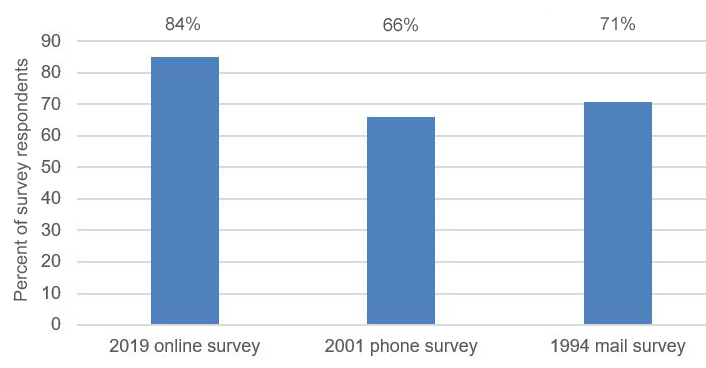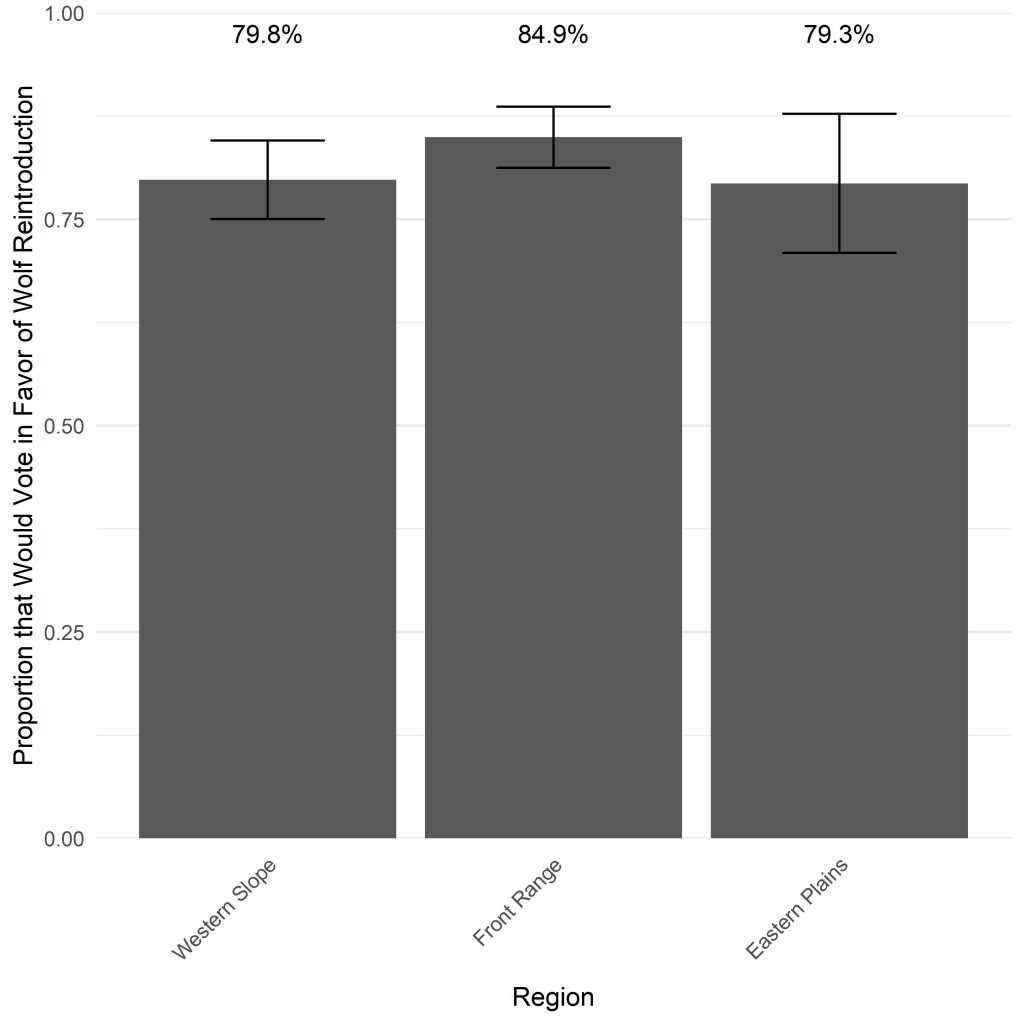by the Center for Human-Carnivore Coexistence (5/20)
Key Points…
- Public attitudes towards wolves and wolf reintroduction are generally positive in the U.S., including Colorado, but can vary by demographics, geography, and stakeholder groups. Both online and mail surveys conducted over the last few decades have found consistent support for wolf reintroduction among a majority of Colorado residents on the Eastern Plains, Front Range, and Western Slope.
- Perceived positive impacts of wolves include the ability of wolves to restore balance to ecosystems and improve the environment, emotional and cultural connections to wolves, wolf viewing opportunities, and moral arguments for wolf restoration (e.g., “it’s the right thing to do”).
- Perceived negative impacts include ranchers incurring costs from wolves preying on livestock, reduced deer and elk populations and hunting opportunities, and threats to the safety of people and pets.
Attitudes Towards Wolves and Wolf Reintroduction in the US and Beyond

Public opinion surveys have been used by social scientists to study the attitudes of the general public and specific stakeholder groups towards wolves and wolf reintroduction. These surveys have found that public attitudes towards wolves are on average positive1,2 and have become more positive across the past several decades.1 However, these attitudes can vary significantly by experience with or proximity to wolves, stakeholder groups, and demographics.2-5 A 2014 survey of U.S. residents found 61% of respondents had positive attitudes towards wolves. 1 Across 38 quantitative public opinion surveys conducted between 1972 and 2000 in the U.S., Canada, and Europe, an average of 51% of all respondents had positive attitudes towards wolves and 60% had positive attitudes towards wolf reintroduction.2 Across these studies, attitudes towards wolves were associated with a variety of different demographic characteristics, such as age, income, and urban/rural residence. 2
Studies suggest that attitudes towards wolf reintroduction are influenced by individuals’ beliefs about the right for wolves to exist as well as their emotional responses to wolves.6,7 People often have strong emotions towards wolves because wolves are seen as representative of broader societal-level conflicts, such as clashes between urban and rural values and the struggle among different stakeholder groups for a say in decision-making about wildlife management (see Dialogue and Social Conflict about Wolves Information Sheet).8,9 Studies have also found that proximity to wolves can influence attitudes. In particular, people living in areas with wolves tend to have more negative attitudes towards wolf conservation than people living outside these areas.2,4 This effect may be due to both direct5 and indirect experiences with wolves4 (e.g., interactions with other people about wolves). An exception is Yellowstone National Park, where visitors from the local area supported wolf reintroduction more than out-of-area visitors.10 These local residents stand to gain substantially from tourism, which may influence their views.10
A 2011 study on willingness to coexist with large carnivores in communities in Washington, Idaho, and Montana where wolves are present provides further insight on public perspectives towards wolves.11 Interviews with community residents indicated that social group (e.g., tribal members, ranchers, non-ranchers), historical context, and management policies influenced attitudes towards wolves. Tribal members were more willing to coexist with wolves, due to their view that living with carnivores is an important part of their cultural heritage. Ranchers felt particularly strongly about the need for lethal control of large carnivores such as wolves, but attitudes about the need for lethal control varied depending on how long wolves have been present on the landscape. Community members in Montana and Idaho with past experience living with wolves more frequently discussed strategies to adapt ranching practices to minimize livestock depredation by wolves. In contrast, a community in Washington where wolves had recently colonized more frequently discussed lethal control of wolves as a strategy to reduce conflict. Communities reported a higher degree of acceptance of wolves where there was a perceived ability to control wolves through management actions. Community members’ perspectives towards wolves were also influenced by whether they felt understood by society and were able to have a voice in decision-making about wolves, pointing to the need for an inclusive process for making policy and management decisions (see Dialogue and Social Conflict about Wolves Information Sheet).
There is mixed evidence on the impact of economic incentives and other management strategies for minimizing human-wolf conflict on public attitudes towards wolves (see Economics of Wolves in Colorado Information Sheet).12 A 2004 study in Sweden found that livestock producers who received subsidies for predator-proof electric fencing tolerated wolves better than those who did not.13 However, economic incentives and wolf management strategies- including legalized predator killing- do not always increase tolerance.12,14,15 For example, a 2001 study in Wisconsin found that livestock producers who were compensated for wolf depredation were not more tolerant than producers who were not compensated for their livestock losses due to wolves.14
Overall Support for Wolf Reintroduction in Colorado
In Colorado, multiple studies have found an overall high level of public support for wolf reintroduction. A 2019 online survey conducted by Colorado State University (CSU) researchers found that 84% of the 734 residents surveyed would vote for wolf reintroduction (see Figure 1).16 People who took the survey represented the Colorado population in terms of age and gender and results were weighted to be representative of region (Eastern Plains, Front Range, and Western Slope). Survey respondents had no knowledge of the survey topic before agreeing to take the survey for pay, so there’s no reason to believe wolf-advocates were over-represented in the survey. Online recruitment may, however, create some bias towards individuals with high technology awareness.
The level of support identified in the 2019 survey was an increase in support from a mail survey conducted by CSU researchers in 1994, which found that 71% of the 1,452 residents surveyed would vote for wolf reintroduction. 17 The 2019 findings also showed a higher level of support compared to a phone survey conducted in 2001, which found that 66% of 500 Colorado residents surveyed were supportive of reintroduction18 (Figure 1). The 2019 and 1994 surveys measured public support by asking residents if they would vote for or against wolf reintroduction without providing any detailed information about wolves and wolf reintroduction. The 2001 survey measured public support before and after providing persuasive arguments for and against wolf reintroduction but found that persuasive arguments had little impact on support.18

Support for Wolf Reintroduction in Colorado by Geography and Stakeholder Groups
Surveys reveal that while support for wolf reintroduction is highest among the urban and Front Range population in Colorado, the majority of rural residents also support reintroduction.16,18 The 2019 survey found that 85% of Front Range residents, 80% of Western Slope residents, and 79% of Eastern Plains residents would vote in favor of wolf reintroduction (see Figure 2).16 The 2019 survey also found that 83% of those from rural areas and 66% of those who strongly identified as hunters would vote for wolf reintroduction. Prior surveys in Colorado have found similar trends. The 1994 survey found that 74% of Eastern Slope residents would support wolf reintroduction compared to 65% of Western Slope residents.17 The 2001 survey, which included residents from Colorado, New Mexico, and Arizona, also found support was highest among urban residents (73%), but the majority of hunters (59%) and people from rural areas (60%) still supported wolf reintroduction.18

Evidence on rancher perspectives towards wolf reintroduction in Colorado is mixed. The 2019 survey found that 70% of people who strongly identified as ranchers would vote for wolf reintroduction.16 The 2001 survey found that 44% of ranchers supported wolf restoration, with an increase to 52% after hearing arguments favoring restoration.18 During a stakeholder workshop on wolf reintroduction hosted by CSU researchers in February 2020, ranchers attending indicated that they were opposed to wolf reintroduction in Colorado because they felt wolves posed a threat to ranchers’ livelihoods (see Dialogue and Social Conflict about Wolves Information Sheet). They also believed that the initiative to reintroduce wolves was failing to give recognition to their previous conservation efforts.19 Overall, further research is needed to fully understand the diversity and prevalence of various rancher perspectives towards wolves and wolf reintroduction.19
Reasons for Public Support and Opposition to Wolf Reintroduction in Colorado
Surveys, interviews, and stakeholder workshops have identified numerous perceived positive and negative impacts of wolves and reasons why people support or oppose wolf reintroduction in Colorado. These perceptions are not always supported by data tracking the ecological and economic impacts of wolves (see other Information Sheets).
Perceived positive impacts of wolf reintroduction mentioned by 2019 survey respondents include the ability of wolves to restore balance to ecosystems and improve the natural environment; the opportunity to view wolves in the wild; emotional and cultural connections to wolves; enhanced tourism opportunities; a reduction in pest populations; and a perceived moral obligation to restore species that once lived in the state.16 Furthermore, at the February 2020 stakeholder workshop, representatives of some environmental groups discussed how they supported wolf reintroduction because they believed it is the first time their values related to wolf conservation are being recognized in decision-making (see Dialogue and Social Conflict about Wolves Information Sheet). They felt they had not received recognition in the past by the state legislature or state wildlife agencies.19
Perceived negative impacts of wolf reintroduction mentioned by the 2019 survey respondents include threats to people and pets, loss of hunting opportunities, and potential wolf attacks on livestock. 16 Similarly, the 1994 survey found that negative attitudes towards wolf reintroduction were associated with beliefs that wolf reintroduction would result in ranchers losing money, wolves wandering into residential areas, and large losses in deer and elk populations.17 During the February 2020 stakeholder workshop, those opposed to reintroduction indicated their belief that the effort to reintroduce wolves was part of a broader trend of society not recognizing their value and contributions to society as well as a pending threat to their economic viability.19
References:
- George, K. A., Slagle, K. M., Wilson, R. S., Moeller, S. J., & Bruskotter, J. T. (2016). Changes in attitudes toward animals in the United States from 1978 to 2014. Biological Conservation, 201, 237-242.
- Williams, C. K., Ericsson, G., & Heberlein, T. A. (2002). A quantitative summary of attitudes toward wolves and their reintroduction (1972-2000). Wildlife Society Bulletin, 575-584.
- Bruskotter, J. T., Schmidt, R. H. and Teel, T. L. (2007). Are attitudes toward wolves changing? A case study in Utah. Biological Conservation, 139 (1–2): 211–218.
- Karlsson, J., & Sjöström, M. (2007). Human attitudes towards wolves, a matter of distance. Biological conservation, 137(4): 610-616.
- Eriksson, M., Sandström, C., & Ericsson, G. (2015). Direct experience and attitude change towards bears and wolves. Wildlife Biology, 21(3), 131-137.
- Bright, A. D., & Manfredo, M. J. (1996). A conceptual model of attitudes toward natural resource issues: a case study of wolf reintroduction. Human Dimensions of Wildlife, 1(1), 1-21.
- Slagle, K. M., Bruskotter, J. T., & Wilson, R. S. (2012). The role of affect in public support and opposition to wolf management. Human Dimensions of Wildlife, 17(1), 44-57.
- Nie, M. A. (2002). Wolf recovery and management as value-based political conflict. Ethics, place & environment, 5(1), 65-71.
- Wilson, M. A. (1997). The wolf in Yellowstone: Science, symbol, or politics? Deconstructing the conflict between environmentalism and wise use. Society & Natural Resources, 10(5), 453-468.
- Duffield, J., Patterson, D. and Neher, C.J. (2006). Wolves and people in Yellowstone: Impacts on the regional economy. University of Montana, Department of Mathematical Sciences.
- Young, J.K., Ma, Z., Laudati, A. and Berger, J. (2015). Human–carnivore interactions: Lessons learned from communities in the American west. Human Dimensions of Wildlife, 20(4), pp.349-366.
- Treves, A. and Bruskotter, J. (2014). Tolerance for predatory wildlife. Science, 344(6183), pp.476-477.
- Karlsson, J. and Sjöström, M. (2011). Subsidized fencing of livestock as a means of increasing tolerance for wolves. Ecology and Society, 16(1).
- Naughton‐Treves, L., Grossberg, R. and Treves, A. (2003). Paying for tolerance: rural citizens’ attitudes toward wolf depredation and compensation. Conservation biology, 17(6), pp.1500-1511.
- Hogberg, J., Treves, A., Shaw, B. and Naughton-Treves, L. (2016). Changes in attitudes toward wolves before and after an inaugural public hunting and trapping season: early evidence from Wisconsin’s wolf range. Environmental Conservation, 43(1), pp.45-55.
- Niemiec RM, Berl REW, Gonzalez M, Teel T, Camara C, Collins M, Salerno J, Crooks K, Schultz S, Breck S, Hoag D. (2020). Public Perspectives and media reporting of wolf reintroduction in Colorado. Peer J.
- Pate, J., Manfredo, M. J., Bright, A. D., & Tischbein, G. (1996). Coloradans’ attitudes toward reintroducing the gray wolf into Colorado. Wildlife Society Bulletin, 421-428.
- Meadow, R., Reading, R. P., Phillips, M., Mehringer, M., & Miller, B. J. (2005). The influence of persuasive arguments on public attitudes toward a proposed wolf restoration in the southern Rockies. Wildlife Society Bulletin, 33(1), 154-163.
- Niemiec RM. (2020). Report: A Summary of Key Perspectives Shared at the February, 2020, Stakeholder Discussion on the Conflict Over Potential Wolf Restoration and Management in Colorado. Fort Collins, CO: Colorado State University, Department of Human Dimensions of Natural Resources.





